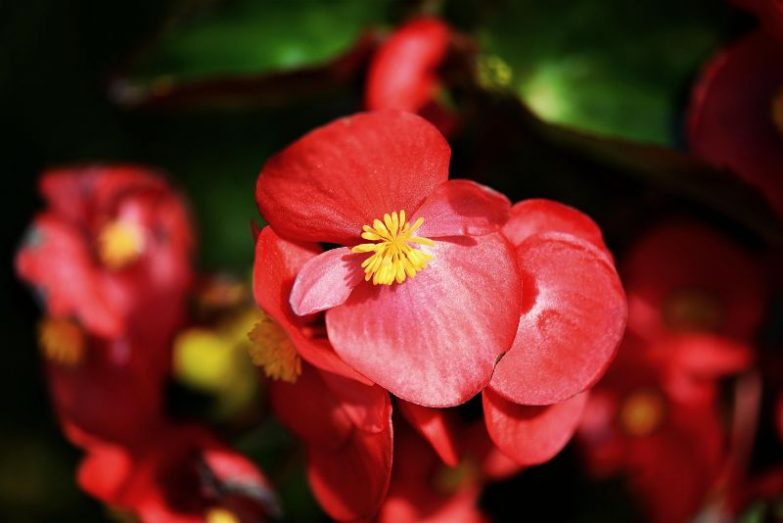Wax begonias are so familiar and commonly kept that it’s easy to take their excellent qualities for granted. Whether used as a landscape bedding flower or a container houseplant, these hardy blooming machines are as forgiving as they are versatile. In this article, we’ll explain everything you need to know about Wax Begonia care.
Summary of Wax Begonia care: Wax Begonias (Begonia Semperflorens-Cultorum Group) bloom throughout their growing season in partial sun. They prefer room temperatures and slightly moist, rich, well-draining soil with light fertilization. They aren’t finicky about humidity and have few pest or disease worries.
Wax Begonia Overview
The cheerful Wax Begonia (Begonia x semperflorens-cultorum) has been popular since the Victorian era. The group contains some of the hardiest members of the 1800+ army of Begonia species. Modern hybrids have more colors and greater sun tolerance than the well-loved favorites of yesteryear.
The Wax Begonia thrives equally well as a houseplant or an outdoor annual; in warm climates, it can be grown as a perennial. Their natural summer-long flowering season can be extended indefinitely indoors in a sunny windowsill. They bloom in clusters of red, white, yellow, or pink flowers, and some varieties are pleasantly fragrant.
The plants stand from six inches to two feet high and feature compact growth with oval-shaped, glossy leaves. The foliage is typically uniform and green, though some varieties have bronze-tinged or reddish leaves. Variegated cultivars also exist.
The Wax Begonia won’t tolerate a frost, but it adapts well to being brought indoors for overwintering. They have a fibrous root system and a mild resistance to brief droughts, and aren’t particularly troubled by pests or disease.
Wax Begonia Care Summary
| Scientific Name | Begonia x semperflorens-cultorum |
| Light Requirements | Bright indirect light. Some varieties can tolerate several hours of full sun per day. |
| Watering | Fairly drought tolerant, but do best in consistently moist soil. Water once the top inch of soil feels dry. |
| Soil | Most potting mixes work well, ideally with 20-30% added drainage amendments such as perlite or bark chips. |
| Temperature | The ideal temperature is 60ºF (16ºC) to 75ºF (24ºC), and tend to flower more profusely at the lower end of this range. |
| Fertilizer | Low fertilizer requirements. Monthly during the growing season with half-strength regular, balanced fertilizer is a good option. |
| Humidity | Quite tolerant of a range of humidity levels, but do best in moderate humidity of 40-60%. |
| Flowering | Beautiful blooms from mid-spring to late fall when grown outside. Can bloom all year round in good light indoors. |
| Pruning | Remove dead foliage and pinch back to prevent your wax begonia from becoming leggy. Otherwise, little pruning is required. |
| Propagation | Can be grown from stem cuttings or seeds quite easily. |
| Re-Potting | Tolerates repotting well, but won’t need repotting until rootbound. |
| Diseases and Pests | Fairly pest resistant, but mealybugs and whitefly are the most likely pests. It can also attract aphids, thrips, and spider mites. Powdery mildew and fungal disease can strike in excessively damp, humid conditions. Reduce the risk by not overwatering and maintaining moderate humidity and ventilation. |
| Toxicity | Mildly toxic to pets and people if ingested. |
| Where To Buy | Buy Wax Begonias online at Etsy (I buy most of my houseplants from Etsy). |

Wax Begonia Light Requirements
The classic Wax Begonia has always brought welcome color to shady areas, but many newer varieties can tolerate full sun. The plant tends to grow more compactly and bloom more profusely with increased sunlight – as long as it isn’t intensely hot.
If you’re planting Wax Begonias outdoors in full sun, it’s best to choose a variety with bronze-colored leaves that manage better in direct light. A plant with green leaves favors a shadier spot. Even sun-tolerant varieties can burn in intense sunlight, though, and may need midday protection.
Indoors, a Wax Begonia can bloom all winter long in adequate light. An eastern or western exposure is a prime location; a south-facing window with protection from the hottest rays is another good choice.
Note: Even green-leaved varieties don’t bloom as abundantly in dim conditions. If you’re not seeing enough flowers, consider increasing the plant’s light.
How To Water Your Wax Begonia
The thick, waxy leaves of a Wax Begonia minimize evaporation. Even though the plant likes consistent moisture, they are mildly drought-tolerant (if the weather isn’t too hot).
It’s best not to water on a schedule – instead, wait until the top inch of soil dries out. This keeps some moisture around the plant’s roots, but remember that it’s easy to overwater and trigger root rot. Never let your Begonia sit in soggy soil!
Allowing the surface to dry not only deters decay pathogens, it also helps reduce soil gnats. The irritating flying pests need evenly damp conditions to proliferate.
Water thoroughly each session and let the excess drain completely. A young Wax Begonia needs more attention: Well-established plants can go longer between soakings.
The best way to water is to put the watering spout or garden hose right up to the base of the plant below the leaves. Overhead watering can promote fungal problems like powdery mildew or leaf spot.
Wax Begonia Soil Requirements
The ideal soil for a Wax Begonia drains well and contains a rich mix of humus. The medium should remain aerated even after watering while retaining some moisture.
Whether you’re planting in a container or in the ground outside, it’s a good idea to mix perlite or another non-decomposing aeration material into the soil. Organic materials like bark or wood chips also provide aeration, but they break down and need regular replacement.
Begonias aren’t too fussy about pH, but they prefer slightly acidic conditions. Adding peat is a good way to promote gentle acidity and increase the water-holding qualities of the soil.
Adding a layer of mulch to the soil surface helps protect the roots from drying out too quickly.

Medium Humidity
One thing that makes Wax Begonia care so much easier indoors is their ability to handle low humidity. They appreciate some moisture in the air, but they actually have problems with mildewed leaves if the humidity is too high.
Occasionally the dryness caused by indoor heating in wintertime can be a challenge. You may see browning on your plant’s leaf edges if it’s struggling with low humidity.
Placing pebble-filled water trays near the plant can raise local humidity the slight amount needed. Grouping Wax Begonias with other transpiring plants can also make a difference. Read my article about increasing humidity for your houseplants to learn more.
Mild Temperatures
Wax Begonias like temperate conditions – they aren’t tolerant of frost and don’t appreciate drafts. They are hardy, year-round perennials outdoors in USDA zones 8-11 and are commonly kept as annuals in colder areas.
The plant’s ideal range is a comfortable 60ºF (16ºC) to 75ºF (24ºC). They appreciate temperatures more on the cool side of the range, though, and don’t flower as freely in hot weather.
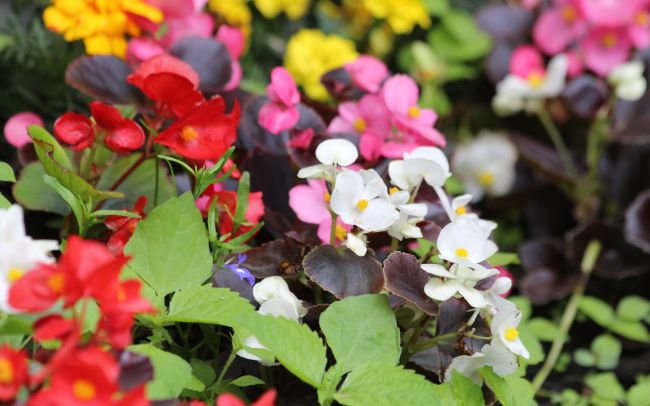
Overwintering
Wax begonias are excellent candidates for being overwintered, whether as bedding plants brought in for protection from the cold or as houseplants returning inside after a summer season.
Houseplants: Wax Begonias readapt quickly when brought indoors before the first frost. Light levels will, of course, be lower than they were used to, but they will continue blooming if given a sunny window.
These tips will make the transition easier:
- Check thoroughly for pest infestations or disease. It’s a good idea to give your plants a good wash as a precaution—it’s almost certain any plant living outdoors has attracted some unwanted passengers.
- When you bring your Wax Begonia inside, give it as much light as possible. Even if you can’t spare a sunny window space, try to put it in the brightest available spot as it acclimates to the indoor environment. This helps to avoid leaf loss and other damage from shock.
- Reduce watering gradually. If the air is particularly arid, modestly increase the plant’s local humidity.
Landscape Plants: Carefully dig up and pot plants before first frost to preserve them and get a head start next season.
These tips help make winter storage successful:
- Lightly cut back foliage and buds to conserve the plant’s energy.
- Let them enter dormancy naturally by exposing the plants to lower light before bringing them indoors. Dig up and pot the plants, and then place them in a shaded area a few weeks before the expected frost date.
- Gradually cut back on watering.
- Store the plant in a cool location indoors with bright, indirect light.
- To bring the plant out of dormancy in the early spring, place it in gentle sunlight to “wake up” before replanting.
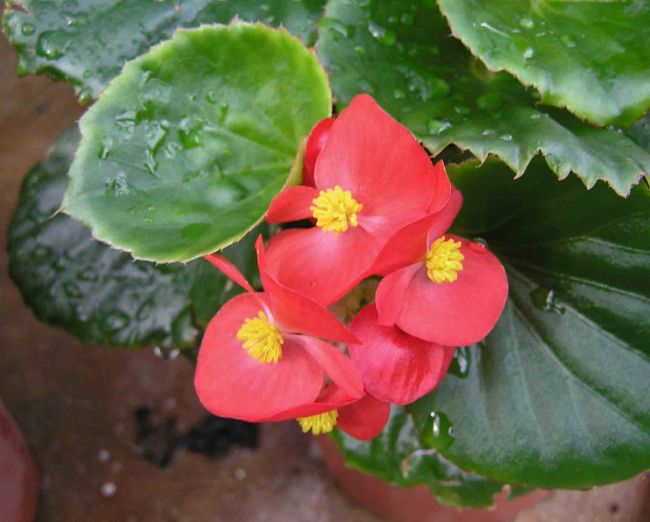
Modest Fertilization
You don’t need a lot of fertilizer to provide good wax begonia care, so beware of overfeeding. The best nutrition starts with a soil rich in organic matter. Use only a half- or even quarter-strength dilution of fertilizer in each application.
Some growers fertilize sparingly once in early spring, and then bi-weekly or monthly over the growing period. Another common method is to make three feedings divided over the entire warm season.
Organic fertilizer is safe and helps promote a healthy soil environment, but synthetics can be effective too. Foliar feeding, however, can cause spotting on their fleshy leaves. If you’d like to learn more, read my guide to fertilizing houseplants here.
Even if the plant is blooming, stop feeding over the winter. You can cut the plant back in early spring, feed them, and begin acclimating them to stronger light for the new year.
Flush the soil regularly: Because the roots are sensitive, it’s important to flush the soil when you water. This simply means to run extra water through the pot for a minute or so. This washes excess fertilizer salts and other chemicals from the soil.
It’s a good practice to thoroughly flush a container plant’s soil every month or so during the growing cycle.
Abundant Flowers
Wax Begonias are champion bloomers. Outdoors, they start up soon after the weather warms up each spring and continue to flower until fall … as houseplants, they can bloom year-round in bright conditions.
They aren’t foolproof, though. Two common issues can lead to flower buds dropping:
Overwatering: Too much water is one of the most common problems when trying to provide good wax begonia care, and can cause the plant to shed blossoms. Poorly draining soil is often the culprit. The solution is to upgrade the soil with aeration materials and organic matter, and only water when the soil surface has dried appropriately.
High Temperatures: Prolonged, elevated heat can trigger bud drop. Shelter the plant from the hot midday sun, and consider protecting the roots with mulch. Watering at noontime can cool the soil.

How To Prune Wax Begonias
Another great thing about these low-maintenance bloom machines is that you don’t need to “deadhead” spent flowers. Wax Begonias shed old blossoms themselves with no slowdown in production. Routine grooming to remove dead or damaged foliage keeps the plant healthy and pristine, but pruning isn’t strictly necessary.
The plant responds nicely to a trim, however: Pinching the tips stimulates growth and encourages bushiness. Cutting back leggy plants will let it regrow in a compact form.
Make cuts about an inch above a leaf node. Note that the nodes face in different directions: some are placed on the outside of a stem; some face inside. Choose outward-facing nodes for pruning so that future branches will grow out and preserve an open structure. Read more about how to prune your houseplants in this guide.
No-Worry Repotting
Repotting isn’t needed too often to provide good wax begonia care. They seem to flower best when a little rootbound, so wait until the roots have filled the pot. One sure sign is when you need to water more than once a week.
More problems happen with overpotting a Wax Begonia than underpotting it, so only go up an inch or possibly two in diameter. If you’re happy with your plant’s size, you can repot back into the same container. Shallow pots work well.
Use the same kind of organic-rich soil when repotting, but don’t fertilize for at least a month afterwards. The tender new roots can easily burn. Read this article for a step by step guide to repotting.
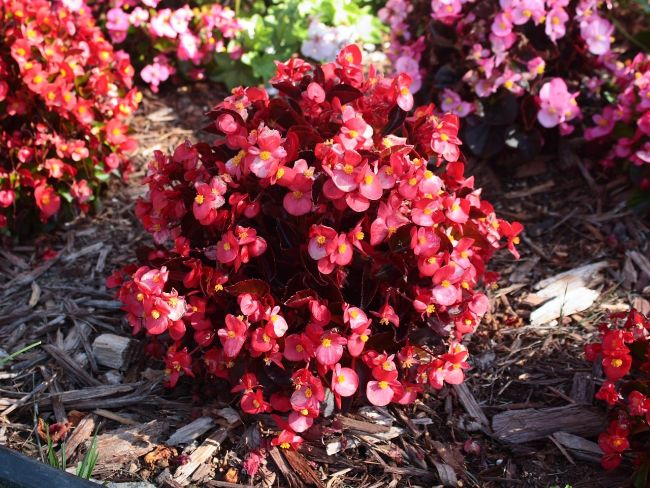
Propagation
Propagating Wax Begonias allows you to economically create mass plantings or grow a hard-to-find color for an indoor centerpiece. There are two common methods:
Growing from Seeds
There are a few tricks to sprouting seeds of a Wax Begonia. The seeds are very small – almost dust-like – and slow to germinate. In addition, they have rather exacting temperature and moisture requirements.
Here’s how it’s done:
- Prepare a seed planter with drainage holes and a clear cover to keep the interior evenly moist. A plastic takeout tray with a transparent lid works well.
- Cover the drainage holes with a half-inch layer of pebbles or uncut sphagnum moss. Add an inch of mixed sand and peat. Top it with a thin layer of fine vermiculite or screened sphagnum. Note: Use a sterile medium to avoid fungal disease.
- Place the container in a tray of water and let the soil wick up the moisture. Drain thoroughly.
- Gently sprinkle the seed “dust” over the topsoil and cover. The seeds don’t need light to germinate. Keep the temperature between 70ºF (21ºC) to 80ºF (27ºC).
- Mist the soil as needed to keep it slightly moist. Wipe off the condensation that develops on the cover.
- Tiny sprouts should appear in about 10 days. Move the tray into bright indirect light. Morning sun is fine.
- After true leaves emerge, begin removing the cover for brief intervals to harden them off. Gradually increase until the seedlings can survive in the open air.
- Transplant after the seedlings have two mature leaves.
Stem Cuttings
Propagating root cuttings is more reliable for hybridized varieties which don’t reproduce accurately from seed. Spring cuttings are best.
Some growers put the stem in water to grow roots, but rotting can be an issue. You can skip that step and plant directly in soil.
- Take cuttings of three to five inches long from the tips, detaching the stem a half-inch below a leaf node. Use a stem with leaves, not flowers.
- Strip the leaves from the lower two inches.
- Plant the cutting two inches deep in potting soil. Rooting hormone isn’t necessary but can speed growth.
- Place the cutting in bright indirect light, and keep the soil damp but not soggy. Consider tenting the cutting to preserve humidity.
- Rooting should begin in a week to 10 days. Transplant the cutting when approximately a month old.
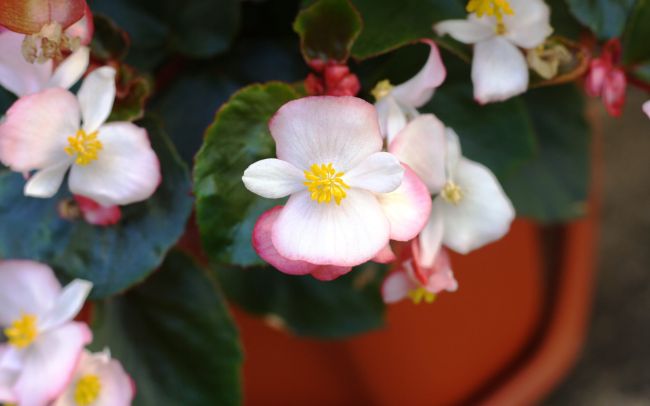
Varieties
Today’s hybrid isn’t the old-fashioned Victorian Begonia. The ongoing march of cultivar creation has spawned compact varieties with bigger blooms than ever before.
One of the fun things about Wax Begonias is exploring the many “series” of cultivars. The Queen, Cocktail, Ambassador, Victory, and Varsity Series are all popular.
Differences between varieties aren’t limited to bloom size or colors. You can find different shapes of foliage and both solid and variegated leaves. Remember that bronze-colored foliage is best in the sun, while green leaves fare better in shade.
Top Wax Begonia Care Tips
- Try increasing the light if your Wax Begonia isn’t flowering well.
- Light can affect leaf size. Specimens in direct sunlight tend to put out smaller foliage; shaded plants bloom less but have larger leaves.
- Ensure the circulation of (warm) air to minimize fungal disease.
- Thoroughly inspect plants before bringing them inside. The thick, waxy leaves may hide unwanted hitchhikers.
- It can be helpful to use a fertilizer higher in phosphorous every third or fourth feeding.
- Compact growth is usually desirable, but watch out for stunted plants. Planting in cold soil below 50ºF (10ºC) can cause stunting, as can excessive heat or prolonged drought.
Be aware that Plant Growth Regulators (PGRs) can also trigger stunting. Paclobutrazol is commonly used by many large nurseries to promote compact growth, and Wax Begonias can react poorly to an excess dose.
- Remove dead and diseased branches before overwintering. They won’t come back and can harbor pests!
Toxic To Pets
Wax begonias are mildly poisonous to pets and horses. They contain calcium oxalates that cause vomiting; high quantities can cause kidney failure. The roots are the most toxic part.
Toxicity isn’t as problematic for people: The sap can be irritating on skin, but the plant itself isn’t considered a danger. In fact, a Wax Begonia’s flowers are considered tasty in salads and other foods.
Few Pests And Diseases
Wax Begonia care is thankfully relatively untroubled by pests. The thick leaves make it somewhat resistant to pests, but they aren’t immune. Mealybugs and whitefly are common, but the plant can also attract aphids, thrips, and spider mites. Infestations can cause leaf discoloration and deformity.
Outdoor plants have to worry about snails and slugs, too. Though somewhat deer resistant, keep in mind that Wax Begonias are not deer-proof.
A dab of isopropyl (rubbing) alcohol kills individual pests. Large, established colonies of mealybugs are difficult to treat … it may be better to safely destroy the plant to limit possible spread.
If you’re committed enough to carry out repeated applications, insecticidal soap or horticultural oil can be effective. You must cover the entire plant with your chosen solution because it has no residual effect.
You can escalate treatment to more toxic pesticides, but consider this risk in light of the usually modest cost of replacement.
Dry Conditions Are The Best Preventative
Powdery mildew and other fungal diseases can strike if humidity is high. Remember to let the topsoil dry out and apply water to the base of the plant, avoiding the leaves.
Botrytis is a more serious problem. Cool weather and moisture can bring it on. Discarding the plant safely is the sure cure, but there are fungicides to help save a prized plant. Disease can spread quickly, so don’t delay.

